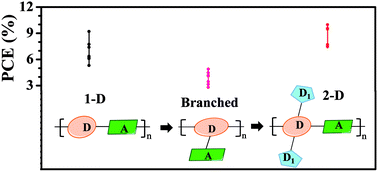Evolving molecular architectures of donor–acceptor conjugated polymers for photovoltaic applications: from one-dimensional to branched to two-dimensional structures
Abstract
Over the last ten years, the molecular architectures of p-type donor–acceptor (D–A) conjugated polymers designed for bulk heterojunction (BHJ) photovoltaics, when mixed with fullerenes or n-type polymers, have progressed substantially from one-dimensional (1-D) to branched to two-dimensional (2-D) D–A conjugated structures. In the 1-D structures, alternating D and A units allow internal charge transfer along the conjugated backbone and increase the effective resonance length, as a result of facilitated π-electron delocalization. Upon progressing from 1-D structures to branched D–A conjugated polymers (comprising repeating donor units in the main chain with electron-withdrawing side chain units) to 2-D conjugated polymers (having D–A repeating units on their backbones as well as perpendicular electron-donating groups on their D units), the solubility, effective conjugation length, and photophysical and BHJ photovoltaic properties have all been altered dramatically. The ideal p-type 2-D conjugated D–A polymer for use in BHJ photovoltaic devices should possess a low band gap (to broaden the absorption range), excellent packing characteristics (particularly along the out-of-plane direction, ensuring good carrier transport), and suitable energy levels for efficient electron transfer (to fullerene moieties or n-type polymers). In this review, we discuss the effects of the structural characteristics and optical properties of these conjugated polymers as well as their packing characteristics on the device performances.

- This article is part of the themed collection: Recent Review Articles


 Please wait while we load your content...
Please wait while we load your content...